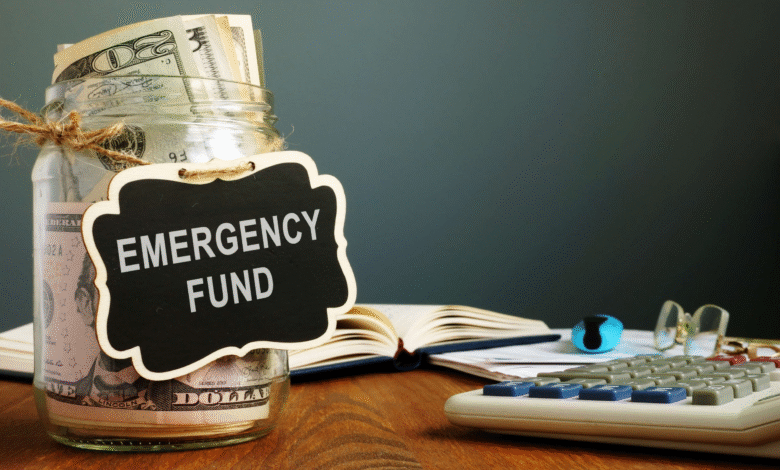Emergency Funds: A Key to Protecting Your 401(k) Savings

Emergency funds act as crucial financial safety nets, allowing individuals to navigate unexpected expenses without jeopardizing their long-term savings, such as 401(k) accounts. According to Vanguard research, having an emergency fund of at least $2,000 significantly decreases the likelihood of early withdrawals from retirement plans, which are often detrimental to retirement security. This “rainy day fund” provides a necessary buffer against financial hardship, fostering a sense of security and stability. By saving as little as $10 to $25 per paycheck, individuals can gradually build an emergency fund that ultimately contributes to better financial health. Therefore, establishing an emergency fund is not only a wise financial strategy but also a fundamental step towards ensuring a more secure retirement.
An emergency savings account, commonly referred to as a rainy day fund, serves as a vital resource for individuals facing financial instability. This safety net is essential for safeguarding 401(k) retirement plans from premature withdrawals that could harm long-term financial goals. Building a reserve can significantly enhance one’s financial resilience, particularly during times of unexpected crises. Research from Vanguard highlights that individuals with accessible savings are less likely to deplete their retirement funds, preserving their financial future. Hence, accumulating a buffer is not simply a prudent measure, but an integral part of securing one’s financial well-being.
Importance of Emergency Funds for Retirement Security
Emergency funds serve as a crucial safety net for individuals looking to secure their financial futures. According to Vanguard research, having at least $2,000 in an emergency fund significantly reduces the likelihood of raiding one’s 401(k) savings during times of financial hardship. This is particularly important as early withdrawals can incur severe penalties and diminish the overall retirement savings accumulated over time. By maintaining a robust rainy-day fund, individuals can protect their retirement assets from unnecessary deductions, thereby enhancing their long-term financial security.
Moreover, when workers have emergency funds, they can better navigate unexpected costs without resorting to premature 401(k) withdrawals. Vanguard’s findings suggest that 401(k) investors with sufficient emergency savings contribute more to their retirement accounts compared to those without them. This proactive savings behavior not only fosters a healthier financial habit but also reinforces the importance of emergency funds in ensuring a secure, stable future as they prepare for retirement.
Understanding 401(k) Leakage and Its Risks
401(k) leakage, a phenomenon where workers prematurely access their retirement savings, poses a significant threat to long-term financial security. According to the Employee Benefit Research Institute, billions are lost in potential retirement savings due to cash-outs and early withdrawals, impacting families’ abilities to retire comfortably. Vanguard emphasizes that individuals without emergency funds are at a higher risk for this type of leakage, demonstrating the critical relationship between immediate liquidity and long-term savings success.
Hourly workers, in particular, are vulnerable to the risks of 401(k) leakage due to the inherent instability in their income. With less financial buffer to absorb unexpected expenses, these individuals may feel compelled to tap into their retirement funds, thereby jeopardizing their future security. Hence, building and maintaining an emergency fund is vital for mitigating these risks, ensuring that workers have the necessary supports in place to safeguard their retirement savings and maintain the stability needed to invest in their futures.
Strategies for Building an Effective Emergency Fund
The first step in building an effective emergency fund is to establish a clear savings goal. Financial advisors generally recommend accumulating enough to cover three to six months of living expenses, which provides a substantial safety net during unforeseen circumstances. For many families struggling to make ends meet, even starting with small amounts, such as $10 or $25 per paycheck, can lead to significant savings over time. The key is to make savings a priority, thereby protecting households from the need to withdraw from their 401(k) accounts.
To facilitate this, individuals should consider automating their savings, which allows for a seamless transfer of funds into a dedicated emergency savings account. By setting up automatic deductions through their employer or bank, savers can gradually grow their rainy day fund without the temptation to spend that money elsewhere. Additionally, capturing financial windfalls, like tax refunds or bonuses, and directing half of that amount into their emergency fund can help them reach their goals faster. This strategic approach not only builds financial resilience but also fortifies retirement savings against potential downturns.
The Role of Behavioral Finance in Saving Habits
Behavioral finance plays a significant role in how individuals structure their savings habits, impacting whether they prioritize building an emergency fund. Studies indicate that emotional and psychological factors can often overrule rational financial planning. For instance, the fear of missing out on immediate gratification can lead individuals to neglect long-term savings objectives. Understanding the triggers that affect spending versus saving can help in creating strategies that compel better financial decision-making, effectively reinforcing the importance of having an emergency fund.
Education surrounding behavioral finance can empower individuals to recognize the value of their emergency funds, which act as a buffer against impulsive financial decisions. By encouraging a mindset shift that prioritizes long-term security over immediate wants, financial literacy programs can be instrumental in changing saving habits. As individuals learn more about the benefits of emergency savings, they are more likely to view it as a vital component of their overall financial wellbeing, reducing the temptation to engage in harmful 401(k) leakage.
Emergency Funds: A Foundation for Financial Independence
Emergency funds do not just provide immediate relief in times of financial distress; they also lay the groundwork for achieving broader financial independence. By securing a cash buffer, individuals can pursue opportunities with more confidence, knowing they have a financial safety net to fall back on if needed. This sense of security enables more strategic financial planning, allowing individuals to focus on growing their 401(k)s and making investments that can lead to greater wealth accumulation.
Furthermore, having a stable emergency fund contributes to reducing the overall stress associated with financial uncertainty. This reduction in anxiety can lead to improved decision-making in other areas of personal finance, including the choices surrounding retirement savings and investments. As a result, individuals not only enhance their immediate financial security but also cultivate a positive mindset towards their long-term financial goals.
Utilizing Financial Tools for Smart Saving
In today’s digital age, various financial tools and apps can assist individuals in building their emergency funds efficiently. These tools can track spending, automate savings, and provide insights into financial health, making it easier for users to understand their saving patterns. By leveraging these technologies, individuals can optimize their savings strategies and ensure they consistently contribute to their emergency fund goals.
Additionally, some platforms offer features like round-up savings, where spare change from purchases is diverted into an emergency fund. Such innovative approaches can help individuals save without feeling the pinch, thereby transforming everyday spending into productive saving habits. By utilizing these financial tools, individuals are better equipped to develop and maintain a stable emergency fund that works in tandem with their long-term retirement savings plans.
Financial Literacy as a Key to Successful Saving
Enhancing financial literacy is integral to fostering sustainable saving practices. Educating individuals on how to build and manage an emergency fund can significantly diminish reliance on 401(k) withdrawals during financial hardships. Programs designed to improve financial literacy can enlighten workers about the potential long-term consequences of early retirement account access, steering them towards more informed decision-making.
Moreover, by equipping individuals with knowledge about budgeting, saving techniques, and the importance of emergency funds, families are more likely to foster a culture of saving within their households. This collective understanding promotes financial stability and encourages a proactive approach to retirement planning, ultimately leading to more secure financial futures.
Emergency Funds and Their Impact on Financial Behavior
The presence of an emergency fund profoundly influences financial behavior, often leading to more prudent financial decisions. Individuals who know they have a safety net are less prone to panic during financial emergencies; thus, they tend to approach unforeseen circumstances with a level of calmness and strategic planning. This mindset minimizes the likelihood of resorting to drastic measures, such as prematurely withdrawing from a 401(k) due to immediate financial pressures.
Research has shown that those with emergency savings are less likely to engage in risky financial behaviors that could jeopardize their long-term goals. For example, having financial cushioning empowers families to wait out short-term financial challenges or invest in more significant opportunities without compromising their long-term savings. As a result, cultivating a robust emergency fund invariably enhances one’s ability to stick to a planned retirement strategy.
How Employer Support Can Enhance Savings Efforts
Employers can play a vital role in enhancing employees’ ability to build emergency funds by offering programs and tools that support saving initiatives. Options such as employer-sponsored savings accounts or matched contributions to emergency funds can create strong incentives for workers to prioritize saving. These employer-driven initiatives can encourage a culture of saving within the workplace, leading employees to view saving as a valued priority.
Additionally, educating employees about the importance of emergency funds during onboarding or financial wellness programs can instill good saving habits from the start. By promoting the link between emergency funds and overall financial wellness, employers can help employees absorb the crucial message of safeguarding their retirement 401(k) plans while navigating daily financial challenges.
Frequently Asked Questions
What is the purpose of an emergency fund and how does it relate to 401(k) savings?
An emergency fund serves as a financial safety net, allowing individuals to cover unexpected expenses without tapping into their 401(k) savings. According to Vanguard research, having an emergency fund of at least $2,000 significantly reduces the likelihood of raiding retirement accounts, thus enhancing overall retirement security.
How much should I save in my emergency fund to avoid financial hardship?
Experts recommend building an emergency fund that covers three to six months’ worth of living expenses. Even a small amount saved, such as $10 to $25 per paycheck, can provide a critical buffer to help you manage financial hardships without resorting to early withdrawals from your 401(k).
What impact does an emergency fund have on retirement security according to Vanguard?
Vanguard’s research indicates that individuals with emergency funds are less likely to experience 401(k) leakage, such as early withdrawals, thereby protecting their retirement savings. Those with emergency savings contribute 2.2 percentage points more to their 401(k), ultimately strengthening their retirement outlook.
Why is it particularly important for hourly workers to have an emergency fund?
Hourly workers often face income volatility, making them more susceptible to financial hardship. Without an emergency fund, they may feel compelled to withdraw from their 401(k) savings during tough times. A robust emergency fund allows these workers to maintain their retirement savings and mitigate the risk of cashing out their accounts.
How can I start building an emergency fund effectively?
To start building an emergency fund, consider setting aside a small amount from each paycheck into a high-yield savings account. Automating your savings can enhance your efforts, ensuring consistent contributions. Over time, even modest savings will accumulate, providing you with a vital safety net away from your 401(k) funds.
What are the consequences of 401(k) leakage due to a lack of an emergency fund?
401(k) leakage, often manifested through cash-outs, can have detrimental effects on retirement security. Early withdrawals incur penalties and potential taxes, leading to significant losses in long-term investment growth. An established emergency fund can help prevent these withdrawals, preserving your retirement assets.
How does having an emergency fund influence my savings behavior towards a 401(k)?
Having an emergency fund can positively influence savings behavior as individuals with such funds are more inclined to contribute towards their 401(k). Vanguard found that those with emergency savings allocate a higher percentage of their income to retirement accounts, reinforcing their long-term financial stability.
What should I consider when choosing where to keep my emergency fund?
When selecting a place for your emergency fund, opt for accounts that offer liquidity and higher interest rates, such as a high-yield savings account or money market fund. This allows your savings to grow while remaining accessible without penalties, thus supporting your financial well-being.
Can I use my emergency fund for purposes other than financial hardship?
While an emergency fund is designed for unexpected expenses, using it wisely is crucial. The fund’s primary intention is to cover genuine emergencies, like medical costs or job loss, rather than discretionary spending. Maintaining this discipline safeguards your financial health and promotes responsible 401(k) management.
| Key Point | Details |
|---|---|
| Emergency Funds Reduce 401(k) Raids | Workers with at least $2,000 in emergency savings are less likely to withdraw from their 401(k) accounts. |
| Impact of 401(k) Leakage | Withdrawal from 401(k) accounts can jeopardize retirement security, especially with early cash-outs leading to tax penalties and lost investment gains. |
| Savings Recommendations | Even small contributions like $10 to $25 per paycheck can be impactful for building an emergency fund. |
| Emergency Funds as a Buffer | Emergency funds provide a cash buffer that helps avoid early withdrawals from retirement accounts when unexpected expenses arise. |
| Support for Hourly Workers | Hourly workers often face income volatility and are more likely to access retirement funds early without an emergency buffer. |
| Building an Emergency Fund | Ideally save 3-6 months of expenses in a liquid account; starting with small amounts can still be beneficial. |
Summary
Emergency funds are crucial for enhancing financial security, particularly in retirement planning. They serve as a preventative measure against the common issue of 401(k) leakage, ensuring individuals do not prematurely withdraw their retirement savings. By starting with even small regular contributions, individuals can build a significant cash reserve that provides peace of mind and financial stability, ultimately supporting a more secure retirement.




